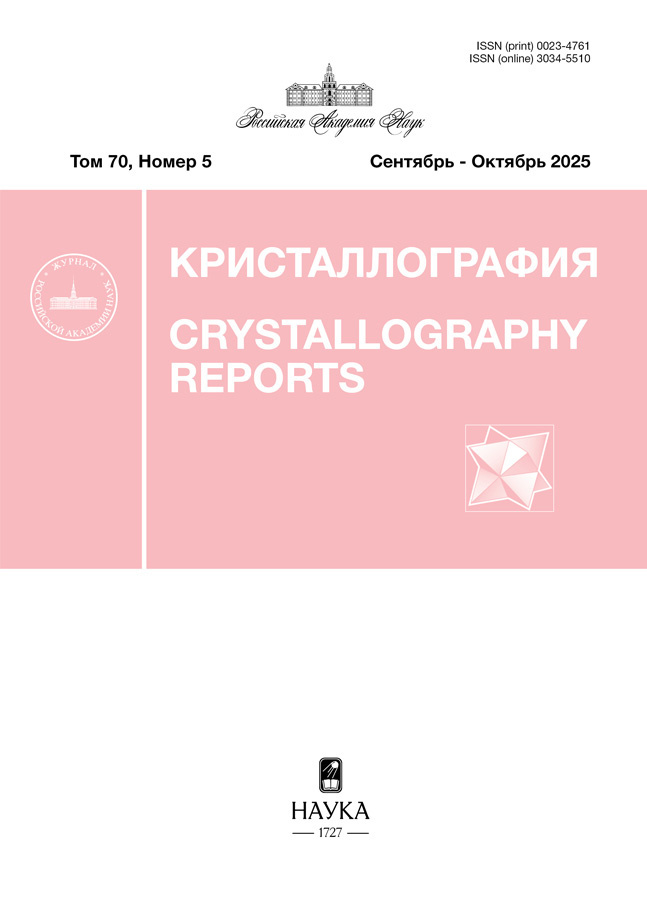Composite perfluorinated membranes modified by polyvinyl alcohol cross-linked with sulfosuccinic acid
- Authors: Primachenko O.N.1, Marinenko E.A.1, Lebedev V.T.2, Orlova V.A.3, Vavilova V.D.1, Gofman I.V.1, Lezova O.S.4, Klechkovskaya V.V.5, Vlasova E.N.1, Kononova S.V.1
-
Affiliations:
- Branch of Konstantinov St. Petersburg Nuclear Physics Institute, National Research Centre “Kurchatov Institute” – Institute of Macromolecular Compounds
- Neutron Researches Department, Konstantinov St. Petersburg Nuclear Physics Institute, National Research Centre “Kurchatov Institute”
- Khlopin Radium Institute
- Branch of Konstantinov St. Petersburg Nuclear Physics Institute, National Research Centre “Kurchatov Institute” – Grebenshchikov Institute of Silicate Chemistry
- Shubnikov Institute of Crystallography of the Kurchatov Complex Crystallography and Photonics of the NRC “Kurchatov Institute”
- Issue: Vol 70, No 5 (2025)
- Pages: 744-758
- Section: STRUCTURE OF MACROMOLECULAR COMPOUNDS
- URL: https://vestnik-pp.samgtu.ru/0023-4761/article/view/693868
- DOI: https://doi.org/10.31857/S0023476125050054
- EDN: https://elibrary.ru/vexkva
- ID: 693868
Cite item
Abstract
About the authors
O. N. Primachenko
Branch of Konstantinov St. Petersburg Nuclear Physics Institute, National Research Centre “Kurchatov Institute” – Institute of Macromolecular Compounds
Email: alex-prima@mail.ru
St. Petersburg, 199004, Russia
E. A. Marinenko
Branch of Konstantinov St. Petersburg Nuclear Physics Institute, National Research Centre “Kurchatov Institute” – Institute of Macromolecular CompoundsSt. Petersburg, 199004, Russia
V. T. Lebedev
Neutron Researches Department, Konstantinov St. Petersburg Nuclear Physics Institute, National Research Centre “Kurchatov Institute”Gatchina, Russia
V. A. Orlova
Khlopin Radium InstituteSt. Petersburg, Russia
V. D. Vavilova
Branch of Konstantinov St. Petersburg Nuclear Physics Institute, National Research Centre “Kurchatov Institute” – Institute of Macromolecular CompoundsSt. Petersburg, 199004, Russia
I. V. Gofman
Branch of Konstantinov St. Petersburg Nuclear Physics Institute, National Research Centre “Kurchatov Institute” – Institute of Macromolecular CompoundsSt. Petersburg, 199004, Russia
O. S. Lezova
Branch of Konstantinov St. Petersburg Nuclear Physics Institute, National Research Centre “Kurchatov Institute” – Grebenshchikov Institute of Silicate Chemistry
Email: svkononova@list.ru
St. Petersburg, 199034, Russia
V. V. Klechkovskaya
Shubnikov Institute of Crystallography of the Kurchatov Complex Crystallography and Photonics of the NRC “Kurchatov Institute”Moscow, 119333, Russia
E. N. Vlasova
Branch of Konstantinov St. Petersburg Nuclear Physics Institute, National Research Centre “Kurchatov Institute” – Institute of Macromolecular CompoundsSt. Petersburg, 199004, Russia
S. V. Kononova
Branch of Konstantinov St. Petersburg Nuclear Physics Institute, National Research Centre “Kurchatov Institute” – Institute of Macromolecular Compounds
Email: svkononova@list.ru
St. Petersburg, 199004, Russia
References
- Kusoglu A., Weber A.Z. // Chem. Rev. 2017. V. 117. P. 987. https://doi.org/10.1021/acs.chemrev.6b00159
- Sigwadi R., Nemavhola F. // Membranes. 2023. V. 13. P. 887. https://doi.org/10.3390/membranes13120887
- Giancola S., Zaton M., Reyes-Carmona A. et al. // J. Membr. Sci. 2019. V. 570–571. P. 69. https://doi.org/10.1016/j.memsci.2018.09.063
- Wang H., Zhang J., Ning X. et al. // Int. J. Hydrogen Energy. 2021. V. 46. P. 25225.
- doi.org/10.1016/j.ijhydene.2021.05.048
- Chen T., Lv B., Sun S. et al. // Membranes. 2023. V. 13. P. 308. https://doi.org/10.3390/membranes13030308
- Prykhodko Y., Fatyeyeva K., Hespel L. et al. // Chem. Engin. J. 2021. V. 409. P. 127329. https://doi.org/10.1016/j.cej.2020.127329
- Gagliardi G.G., Ibrahim A., Borello D. et al. // Molecules. 2020. V. 25. P. 1712. https://doi.org/10.3390/molecules25071712
- Arslanova A.A., Sanginov E.A., Dobrovol,srii Yu.A. // Rus. J. Electrochem. 2018. V. 54. P. 318. https://doi.org/10.1134/S1023193518030035
- Ali N., Ali F., Khan S. et al. // J. Mol. Struct. 2021. V. 1231. P. 129940. https://doi.org/10.1016/j.molstruc.2021.129940
- Boaretti C., Pasquini L., Sood R. et al. // J. Membr. Sci. 2018. V. 545. P. 66. http://dx.doi.org/10.1016/j.memsci.2017.09.055
- Фалина И.В., Березина Н.П. // Высокомол. соед. Сер. Б. 2010. Т. 52. С. 715.
- Bolto B., Tran T., Hoang M. et al. // Prog. Polym. Sci. 2009. V. 34. P. 969. https://doi.org/10.1016/j.progpolymsci.2009.05.003
- Lyozova O.S., Zagrebelny O.A., Krasnopeeva E.L. et al. // Glass Phys. Chem. 2021. V. 47. P. 173. https://doi.org/10.1134/S1087659621020061
- Lezova O.S., Myasnikov D.V., Shilova O.A. et al. // Int. J. Hydrogen Energy. 2022. V. 47. P. 4846. https://doi.org/10.1016/j.ijhydene.2021.11.158
- Bakangura E., Wu L., Ge L. et al. // Progr. Polym. Sci. 2016. V. 57. P. 103. http://dx.doi.org/10.1016/j.progpolymsci.2015.11.004 0079-6700
- Kim D.J., Jo M.J., Nam S.Y. // J. Ind. Engin. Chem. 2015. V. 21. P. 36. http://dx.doi.org/10.1016/j.jiec.2014.04.030
- Liu C.-P., Dai C.-A., Chao C.-Y. et al. // J. Power Sources. 2014. V. 249. P. 285. http://dx.doi.org/10.1016/j.jpowsour.2013.10.117
- Primachenko O.N., Marinenko E.A., Gubanova G.N. et al. // Russ. J. Gen. Chem. 2024. V. 94. P. 853. https://doi.org/10.1134/S1070363224040121
- Tsai C.-E., Lin C.-W., Hwang B.-J. // J. Power Sources. 2010. V. 195. P. 2166. https://doi.org/10.1016/j. jpowsour.2009.10.055
- Барбашов В.И., Чайка Э.В. // Физика и техника высоких давлений. 2019. Т. 29. С. 116.
- Барбашов В.И., Чайка Э.В. // Физика и техника высоких давлений. 2021. Т. 31. С. 39.
- Dong F., Xu S., Wu X. et al. // Separ. Purificat. Technol. 2021. V. 267. P. 118629. https://doi.org/10.1016/j.seppur.2021.118629
- Rhim J., Park H., Lee C. et al. // J. Membr. Sci. 2004. V. 238. P. 143. https://doi.org/10.1016/j.memsci.2004.03.030
- Rao A.S., Rashmi K.R., Manjunatha D.V. et al. // Mater. Today Proc. 2021. V. 35. P. 344. https://doi.org/10.1016/j.matpr.2020.02.093
- Molla S., Compan V., Gimenez E. et al. // Int. J. Hydrogen Energy. 2011. V. 36. P. 9886. https://doi.org/10.1016/j.ijhydene.2011.05.074
- Ivanchev S.S., Likhomanov V.S., Primachenko O.N. et al. // Petr. Chem. 2012. V. 52. P. 453. https://doi.org/10.1134/S0965544112070067
- Primachenko O.N., Odinokov A.S., Marinenko E.A. et al. // J. Fluor. Chem. 2021. V. 244. P. 109736. https://doi.org/10.1016/j.jfluchem.2021.109736
- Kim H., Lee S., Kim S. et al. // J. Mater. Sci. 2017. V. 52. P. 2400. https://doi.org/10.1007/s10853-016-0534-z
- De Bonis C., Cozzi D., Mecheri B. et al. // Electrochim. Acta. 2014. V. 147. P. 418. https://doi.org/10.1016/j.electacta.2014.09.135
- Сафронова Е.Ю., Воропаева Д.Ю., Новикова С.А. и др. // Мембраны и мембранные технологии. 2022. Т. 12. С. 47. https://doi.org/10.1134/S221811722201007
- Примаченко О.Н., Кульвелис Ю.В., Лебедев В.Т. и др. // Мембраны и мембранные технологии. 2020. Т. 10. С. 3. https://doi.org/10.1134/S221811722001006X
Supplementary files











